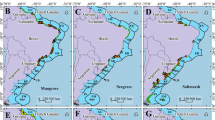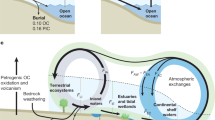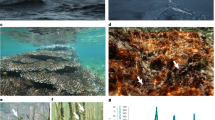Abstract
The coastal ocean represents an important global carbon sink and is a focus for interventions to mitigate climate change and meet the Paris Agreement targets while supporting biodiversity and other ecosystem functions. However, the fate of the flux of carbon exported from seaweed forests—the world’s largest coastal vegetated ecosystem—is a key unknown in marine carbon budgets. Here we provide national and global estimates for seaweed-derived particulate carbon export below 200 m depth, which totalled 3–4% of the ocean carbon sink capacity. We characterized export using models of seaweed forest extent, production and decomposition, as well as shelf–open ocean water exchange. On average, 15% of seaweed production is estimated to be exported across the continental shelf, which equates to 56 TgC yr−1 (range: 10–170 TgC yr−1). Using modelled sequestration timescales below 200 m depth, we estimated that each year, 4–44 Tg seaweed-derived carbon could be sequestered for 100 years. Determining the full extent of seaweed carbon sequestration remains challenging, but critical to guide efforts to conserve seaweed forests, which are in decline globally. Our estimate does not include shelf burial and dissolved and refractory carbon pathways; still it highlights a relevant potential contribution of seaweed to natural carbon sinks.
This is a preview of subscription content, access via your institution
Access options
Access Nature and 54 other Nature Portfolio journals
Get Nature+, our best-value online-access subscription
$29.99 / 30 days
cancel any time
Subscribe to this journal
Receive 12 print issues and online access
$259.00 per year
only $21.58 per issue
Buy this article
- Purchase on Springer Link
- Instant access to full article PDF
Prices may be subject to local taxes which are calculated during checkout



Similar content being viewed by others
Data availability
Data for national and ecoregion area estimates, percentage export, carbon export, NPP, decomposition and other parameters are available in Supplementary Data 1. Additional information on uncertainties around parameters and assumptions are provided in Supplementary Information. Predictive layers and model outputs of CRT, percentage export data and POC export are available at figshare (https://doi.org/10.6084/m9.figshare.24116973) (ref. 77). Areal estimates for floating and sinking seaweed forest were modelled from species occurrence records51 and stacked distribution estimates32 that are openly available at figshare (https://doi.org/10.6084/m9.figshare.14496018.v4) (ref. 75). Benthic currents and bathymetric data are available from Bio-ORACLE76. Source data for net primary productivity models are openly available4, and the dataset is described in Scientific Data (https://doi.org/10.1038/s41597-022-01554-5). Source CRTs33 are archived at NOAA GFDL (ftp://data1.gfdl.noaa.gov/users/Xiao.Liu/CRT_simulation/GFDL-MOM6-SIS2/).
Code availability
Source code is available at figshare (https://doi.org/10.6084/m9.figshare.24116973)77.
References
Boyd, P. et al. Multi-faceted particle pumps drive carbon sequestration in the ocean. Nature 568, 327–335 (2019).
Henson, S. A. et al. Uncertain response of ocean biological carbon export in a changing world. Nat. Geosci. https://doi.org/10.1038/s41561-022-00927-0 (2022)
Duarte, C. M., Gattuso, J., Hancke, K., Gundersen, H. & Filbee-Dexter, K. Global estimates of the extent and production of macroalgal forests. Glob. Ecol. Biogeogr. 31, 1422–1439 (2022).
Pessarrodona, A. et al. Global seaweed productivity. Sci. Adv. 8, 2465 (2022).
Watanabe, K. et al. Macroalgal metabolism and lateral carbon flows can create significant carbon sinks. Biogeosciences 17, 2425–2440 (2020).
Weigel, B. L. & Pfister, C. A. The dynamics and stoichiometry of dissolved organic carbon release by kelp. Ecology 102, e03221 (2021).
Krumhansl, K. & Scheibling, R. Production and fate of kelp detritus. Mar. Ecol. Prog. Ser. 467, 281–302 (2012).
Filbee-Dexter, K., Wernberg, T., Ramirez-Llodra, E., Norderhaug, K. M. & Pedersen, M. F. Movement of pulsed resource subsidies from shallow kelp forests to deep fjords. Oecologia 187, 291–304 (2018).
Fram, J. P. et al. Physical pathways and utilization of nitrate supply to the giant kelp, Macrocystis pyrifera. Limnol. Oceanogr. 53, 1589–1603 (2008).
Vetter, E. W. & Dayton, P. K. Macrofaunal communities within and adjacent to a detritus-rich submarine canyon system. Deep Sea Res. 2 45, 25–54 (1998).
Krause-Jensen, D. & Duarte, C. M. Substantial role of macroalgae in marine carbon sequestration. Nat. Geosci. 9, 737–742 (2016).
Queiros, A. M. et al. Connected macroalgal–sediment systems: blue carbon and food webs in the deep coastal ocean. Ecol. Monogr. 89, e01366 (2019).
Pessarrodona, A. et al. Carbon sequestration and climate change mitigation using macroalgae: a state of knowledge review. Biol. Rev. https://doi.org/10.1111/brv.12990 (2023).
Ortega, A. et al. Important contribution of macroalgae to oceanic carbon sequestration. Nat. Geosci. 12, 748–754 (2019).
Hurd, C. L. et al. Forensic carbon accounting: assessing the role of seaweeds for carbon sequestration. J. Phycol. 58, 347–363 (2022).
Macreadie, P. I. et al. Operationalizing marketable blue carbon. One Earth 5, 485–492 (2022).
Filbee-Dexter, K. & Wernberg, T. Substantial blue carbon in overlooked Australian kelp forests. Sci. Rep. 10, 12341 (2020).
Ager, T. G. et al. Macroalgal habitats support a sustained flux of floating biomass but limited carbon export beyond a Greenland fjord. Sci. Total Environ. 872, 162224 (2023).
Queirós, A. M. et al. Identifying and protecting macroalgae detritus sinks toward climate change mitigation. Ecol. Appl. https://doi.org/10.1002/EAP.2798 (2022).
Vanderklift, M. A. et al. A guide to international climate mitigation policy and finance frameworks relevant to the protection and restoration of blue carbon ecosystems. Front. Mar. Sci. https://doi.org/10.3389/fmars.2022.872064 (2022).
Broch, O. J., Hancke, K. & Ellingsen, I. H. Dispersal and deposition of detritus from kelp cultivation. Front Mar. Sci. 9, 840531 (2022).
Filbee-Dexter, K. et al. Kelp carbon sink potential decreases with warming due to accelerating decomposition. PLoS Biol. 20, e3001702 (2022).
Harrold, C. & Lisin, S. Radio-tracking rafts of giant kelp: local production and regional transport. J. Exp. Mar. Biol. Ecol. 130, 237–251 (1989).
Dai, M. et al. Carbon fluxes in the coastal ocean: synthesis, boundary processes, and future trends. Ann. Rev. Earth Planet. Sci. 50, 593–626 (2022).
Hofmann, E. E. et al. Modeling the dynamics of continental shelf carbon. Ann. Rev. Mar. Sci. 3, 93–122 (2011).
Pedersen, M., Filbee-Dexter, K., Frisk, N., Sárossy, Z. & Wernberg, T. Carbon sequestration potential increased by incomplete anaerobic decomposition of kelp detritus. Mar. Ecol. Prog. Ser. https://doi.org/10.3354/meps13613 (2021).
Trevathan-Tackett, S. M. et al. Comparison of marine macrophytes for their contributions to blue carbon sequestration. Ecology 96, 3043–3057 (2015).
Queirós, A. M. et al. Connected macroalgal–sediment systems: blue carbon and food webs in the deep coastal ocean. Ecol. Monogr. https://doi.org/10.1002/ecm.1366 (2019).
Frigstad, H. et al. Blue Carbon—Climate Adaptation, CO2 Uptake and Sequestration of Carbon in Nordic Blue Forests (Nordic Council of Ministers, 2021); https://doi.org/10.6027/temanord2020-541
Allen, S. E. & Durrieu de Madron, X. A review of the role of submarine canyons in deep-ocean exchange with the shelf. Ocean Sci. 5, 607–620 (2009).
Siegel, D. A., DeVries, T., Doney, S. C. & Bell, T. Assessing the sequestration time scales of some ocean-based carbon dioxide reduction strategies. Environ. Res. Lett. 16, 104003 (2021).
Fragkopoulou, E. et al. Global biodiversity patterns of marine forests of brown macroalgae. Glob. Ecol. Biogeogr. 31, 636–648 (2022).
Liu, X. et al. Simulating water residence time in the coastal ocean: a global perspective. Geophys. Res. Lett. 46, 13910–13919 (2019).
Nowicki, M., DeVries, T. & Siegel, D. A. Quantifying the carbon export and sequestration pathways of the ocean’s biological carbon pump. Glob. Biogeochem. Cycles 36, e2021GB007083 (2022).
Friedlingstein, P. et al. Global carbon budget. Earth Syst. Sci. Data 14, 1917–2005 (2022).
De La Rocha, C. L. & Passow, U. in Treatise on Geochemistry 2nd edn, Vol. 8 (eds Holland, H. D. & Turekian, K. K.) 93–122 (Elsevier, 2014).
Hernández-León, S. et al. Large deep-sea zooplankton biomass mirrors primary production in the global ocean. Nat. Commun. 11, 11 (2020).
Cooley, S. et al. in IPCC Climate Change 2022: Impacts, Adaptation and Vulnerability (eds Pörtner, H.-O. et al) Ch. 3 (Cambridge Univ. Press, 2022).
Smith, S. V. Marine macrophytes as a global carbon sink. Science 211, 838–840 (1981).
Arndt, S. et al. Quantifying the degradation of organic matter in marine sediments: a review and synthesis. Earth Sci. Rev. 123, 53–86 (2013).
Smith, R. W., Bianchi, T. S., Allison, M., Savage, C. & Galy, V. High rates of organic carbon burial in fjord sediments globally. Nat. Geosci. 8, 450–453 (2015).
Macreadie, P. I. et al. The future of blue carbon science. Nat. Commun. 10, 3998 (2019).
Buck-Wiese, H. et al. Fucoid brown algae inject fucoidan carbon into the ocean. Proc. Natl Acad. Sci. USA 120, 2210561119 (2023).
Li, H. et al. Carbon sequestration in the form of recalcitrant dissolved organic carbon in a seaweed (kelp) farming environment. Environ. Sci. Technol. 56, 9112–9122 (2022).
Paine, E. R., Schmid, M., Boyd, P. W., Diaz-Pulido, G. & Hurd, C. L. Rate and fate of dissolved organic carbon release by seaweeds: a missing link in the coastal ocean carbon cycle. J. Phycol. https://doi.org/10.1111/jpy.13198 (2021).
van der Mheen, M. et al. Substantial kelp detritus exported beyond the continental shelf by dense shelf water transport. Sci. Rep. 14, 839 (2024).
Wernberg, T., Krumhansl, K. A., Filbee-Dexter, K. & Pedersen, M. F. in World Seas: An Environmental Evaluation 2nd edn, Vol. 3 (ed. Sheppard, C.) 57–78 (Academic Press, 2019).
Filbee-Dexter, K. et al. Leveraging the blue economy to transform marine forest restoration. J. Phycol. 58, 198–207 (2022).
Krause-Jensen, D. et al. Imprint of climate change on pan-Arctic marine vegetation. Front. Mar. Sci. 7, 617324 (2020).
Amsler, C. D. et al. Strong correlations of sea ice cover with macroalgal cover along the Antarctic Peninsula: ramifications for present and future benthic communities. Elementa 11, 00020 (2023).
Assis, J. et al. A fine-tuned global distribution dataset of marine forests. Sci. Data 7, 119 (2020).
Fairhead, V. A. Ecophysiology and Production Ecology of the Kelp Ecklonia radiata (C.Agardh) J.Agardh, at West Island, South Australia. PhD thesis, Univ. Adelaide (2001).
Wright, L. S., Pessarrodona, A. & Foggo, A. Climate-driven shifts in kelp forest composition reduce carbon sequestration potential. Glob. Change Biol. 28, 5514–5531 (2022).
Spalding, M. D. et al. Marine ecoregions of the world: a bioregionalization of coastal and shelf areas. Bioscience 57, 573–583 (2007).
Griffies, S. M., Adcroft, A. & Hallberg, R. A primer on the vertical Lagrangian‐remap method in ocean models based on finite volume generalized vertical coordinates. J. Adv. Model. Earth Syst. 12, 10 (2020).
Mahjabin, T., Pattiaratchi, C. & Hetzel, Y. Occurrence and seasonal variability of Dense Shelf Water Cascades along Australian continental shelves. Sci. Rep. 10, 9732 (2020).
Smale, D. A., Pessarrodona, A., King, N. & Moore, P. J. Examining the production, export, and immediate fate of kelp detritus on open-coast subtidal reefs in the Northeast Atlantic. Limnol. Oceanogr. 67, S36–S49 (2022).
Filbee-Dexter, K. & Scheibling, R. E. Spatial patterns and predictors of drift algal subsidy in deep subtidal environments. Estuaries Coasts 39, 1724–1734 (2016).
Britton-Simmons, K. H. et al. Habitat and bathymetry influence the landscape‐scale distribution and abundance of drift macrophytes and associated invertebrates. Limnol. Oceanogr. 57, 176–184 (2012).
Frontier, N., de Bettignies, F., Foggo, A. & Davoult, D. Sustained productivity and respiration of degrading kelp detritus in the shallow benthos: detached or broken, but not dead. Mar. Environ. Res. 166, 105277 (2021).
Young, A. P. & Carilli, J. E. Global distribution of coastal cliffs. Earth Surf. Process. Landf. 44, 1309–1316 (2019).
Martin, J. H., Knauer, G. A., Karl, D. M. & Broenkow, W. W. VERTEX: carbon cycling in the northeast Pacific. Deep Sea Res. A 34, 267–285 (1987).
Lauderdale, J. M. & Cael, B. B. Impact of remineralization profile shape on the air–sea carbon balance. Geophys. Res. Lett. 48, e2020GL091746 (2021).
Guidi, L. et al. A new look at ocean carbon remineralization for estimating deepwater sequestration. Glob. Biogeochem. Cycles 29, 1044–1059 (2015).
Buesseler, K. O. & Boyd, P. W. Shedding light on processes that control particle export and flux attenuation in the twilight zone of the open ocean. Limnol. Oceanogr. 54, 1210–1232 (2009).
Hobday, A. J. Abundance and dispersal of drifting kelp Macrocystis pyrifera rafts in the Southern California Bight. Mar. Ecol. Prog. Ser. 195, 101–116 (2000).
Barnier, B., Penduff, T. & Langlais, C. in Operational Oceanography in the 21st Century (eds Schiller, A. & Brassington, G. B.) 239–262 (Springer, 2011).
Olascoaga, M. J., Beron-Vera, F. J. & Miron, P. Observation and quantification of inertial effects on the drift of floating objects at the ocean surface. Phys. Fluids 32, 26601 (2020).
Krumhansl, K. & Scheibling, R. Detrital production in Nova Scotian kelp beds: patterns and processes. Mar. Ecol. Prog. Ser. 421, 67–82 (2011).
Pedersen, M. F. et al. Detrital carbon production and export in high latitude kelp forests. Oecologia 192, 227–239 (2020).
Wernberg, T. & Filbee-Dexter, K. Grazers extend blue carbon transfer by slowing sinking speeds of kelp detritus. Sci. Rep. 8, 17180 (2018).
Carvajalino-Fernández, M. A., Sævik, P. N., Johnsen, I. A., Albretsen, J. & Keeley, N. B. Simulating particle organic matter dispersal beneath Atlantic salmon fish farms using different resuspension approaches. Mar. Pollut. Bull. 161, 111685 (2020).
D’Asaro, E. A. et al. Ocean convergence and the dispersion of flotsam. Proc. Natl Acad. Sci. USA 115, 1162–1167 (2018).
Holzer, M., DeVries, T. & de Lavergne, C. Diffusion controls the ventilation of a Pacific Shadow Zone above abyssal overturning. Nat. Commun. 12, 4348 (2021).
Fragkopoulou, E. et al. Global diversity patterns of marine forests of brown microalgae. figshare https://doi.org/10.6084/m9.figshare.14496018.v4 (2021).
Assis, J. et al. Bio‐ORACLE v2.0: extending marine data layers for bioclimatic modelling. Glob. Ecol. Biogeogr. 27, 277–284 (2018).
Filbee-Dexter, K. et al. Carbon export from seaweed forests to deep ocean sinks. figshare https://doi.org/10.6084/m9.figshare.24116973 (2024).
R Core Team. R: A language and environment for statistical computing. https://www.R-project.org/ (R Foundation for Statistical Computing, 2021).
Acknowledgements
This work was supported by the Norwegian Blue Forest Network and EUROMARINE (FWS_07-2018). The project was funded by the Australian Research Council (DE190100692, FT230100214, DP220100650, LP220200004) to K.F.-D., T.W. and A.P., the Independent Research Fund Denmark (8021-00222 B, ‘CARMA’) to D.K.-J., and the Foundation for Science and Technology (UIDB/04326/2020, UIDP/04326/2020, LA/P/0101/2020) and Individual Call to Scientific Employment Stimulus (2022.00861.CEECIND/CP1729/CT0003) to J.A. Flume experiments used for benthic transport were conducted in collaboration with A. Pomeroy.
Author information
Authors and Affiliations
Contributions
K.F.-D., A.P., M.F.P., T.W., C.M.D., J.A., T.B., M.T.B., D.F.C., J.-P.G., H.G., K.H., K.A.K., T.K., J.J.M., P.J.M., A.M.Q., D.A.S., I.S.P., N.S. and D.K.-J. conceptualized this study over two workshops, one led by D.K.-J. and C.M.D. and one led by K.F.-D. K.F.-D. ran the simulations, analysed the data and wrote the original draft of the manuscript, with contributions from A.P., M.F.P., T.W. and D.K.-J. The seaweed forest area distributions were calculated by J. A., the data on percentage net primary production exported as detrital materials were compiled by A.P. and K.A.K., and the decomposition rates were compiled by M.F.P. A.P., M.F.P., T.W., C.M.D., J.A., T.B., M.T.B., D.F.C., J.-P.G., H.G., K.H., K.A.K., T.K., J.J.M., P.J.M., A.M.Q., D.A.S., I.S.P., N.S. and D.K.-J. provided inputs to the writing and comments on the final draft.
Corresponding author
Ethics declarations
Competing interests
The authors declare no competing interests.
Peer review
Peer review information
Nature Geoscience thanks Alecia Bellgrove, Charlotte Laufkötter, Matthias Schmid and the other, anonymous, reviewer(s) for their contribution to the peer review of this work. Primary Handling Editor: James Super, in collaboration with the Nature Geoscience team.
Additional information
Publisher’s note Springer Nature remains neutral with regard to jurisdictional claims in published maps and institutional affiliations.
Extended data
Extended Data Fig. 1 Seaweed carbon decomposition.
Range of decomposition rates (k) for brown seaweed genera. Dashed line shows global mean. Boxplots show the median and 25th and 75th percentiles and whiskers show 1.5 the inter-quartile range. Number of data points are shown in brackets. One outlier value for Nereocystis (k = 1.33) is not shown to aid visualization.
Extended Data Fig. 2 Flux of seaweed carbon to deep ocean.
Estimates of the total particulate organic carbon (POC) exported across the shelf and below 200-m depth in TgC y−1 for each ecoregion. Map shapefiles from Natural Earth.
Supplementary information
Supplementary Information
Sources of uncertainty and sensitivity analysis.
Supplementary Data 1
Data for national and ecoregion area estimates, percentage export, carbon export, NPP, decomposition and other parameters.
Rights and permissions
Springer Nature or its licensor (e.g. a society or other partner) holds exclusive rights to this article under a publishing agreement with the author(s) or other rightsholder(s); author self-archiving of the accepted manuscript version of this article is solely governed by the terms of such publishing agreement and applicable law.
About this article
Cite this article
Filbee-Dexter, K., Pessarrodona, A., Pedersen, M.F. et al. Carbon export from seaweed forests to deep ocean sinks. Nat. Geosci. (2024). https://doi.org/10.1038/s41561-024-01449-7
Received:
Accepted:
Published:
DOI: https://doi.org/10.1038/s41561-024-01449-7



